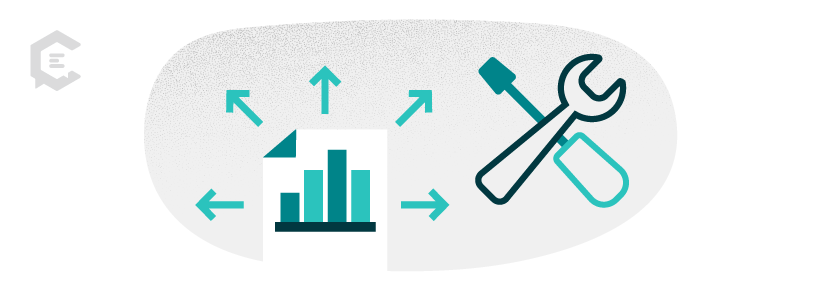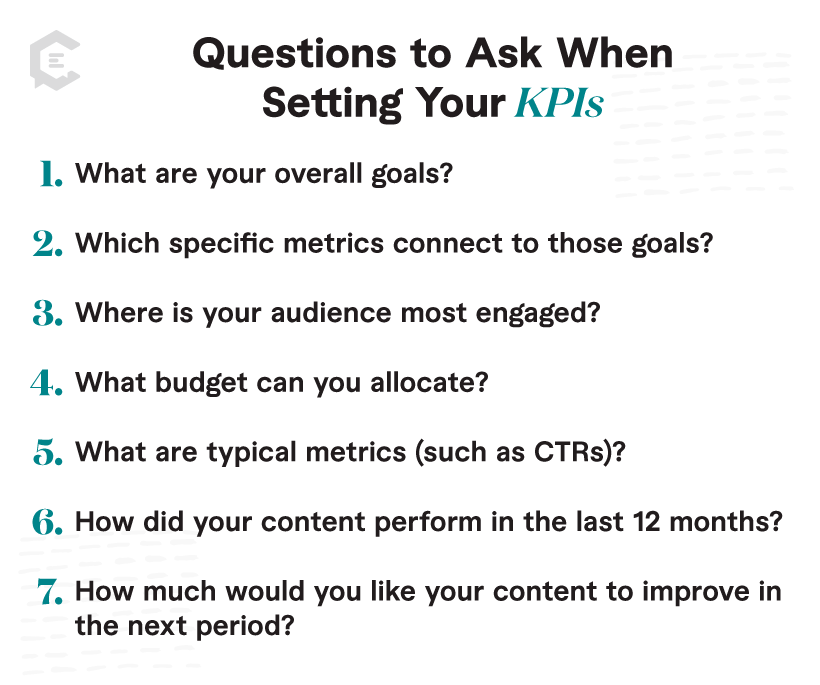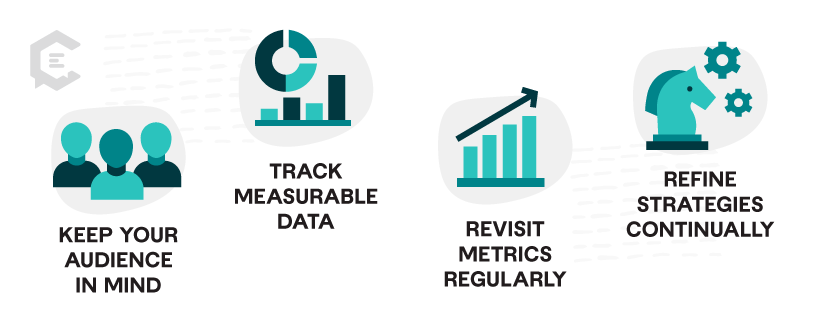It’s easy to set targets. You know you want to generate X leads by the end of the quarter. Or you want $Y in revenue by the end of the year. But how are you getting to those targets?
While moving toward a target is helpful, having smaller goals is good to ensure you’re on the right path. That’s where your marketing program’s key performance indicators (KPIs) come in. KPIs provide a framework for measuring performance, guiding decisions, and optimizing strategies.
This article provides the ultimate guide to KPIs to help you measure the effectiveness of your content performance and distribution strategies.

Key Metrics for Content Distribution
“There are three objectives for content marketing: reach, engagement, conversion. Define key metrics for each.” — Michael Brenner, CEO, Marketing Insider Group

Thanks to the nature of digital content marketing, there are almost too many metrics to track. To keep your KPIs manageable, here are the most important figures to watch in different areas.
Reach and Exposure
With all content marketing, step one is to see if people are reading it.
Reach refers to the total number of users who visit a page. While exposure measures the frequency and depth of audience engagement. The important KPIs for these goals are:
- Unique Visitors: The number of people visiting your site
- Page Views: The total number of eyes on a particular page, including repeat visitors
- Impressions: The number of people who saw your URL in organic search
Engagement Metrics
Now that you’re tracking if people are seeing your content, it’s time to see if they liked it. A user may engage with content by clicking a link, completing a form, or taking any other action. The key engagement KPIs are:
- Click-through Rates (CTR): The number of people who click through to your content from search engines
- Time on Page: How long, on average, someone stays reading your content
- Social Shares: The number of people who reposted your content to other sites like Facebook or Twitter
- Comments: Any comments left on your page
Conversion Metrics
Conversion metrics measure the effectiveness of your content in driving desired actions. These KPIs tend to be the most important because they are directly linked to company goals.
- Leads Generated: The number of leads acquired from marketing
- Conversion Rate: How many people take a desired action versus visiting a page
- Cost per Acquisition (CPA): Total marketing spend divided by number of conversions
Content Distribution Advanced KPIs to Monitor
Once you’ve mastered the basics, tracking even more detailed KPIs can help strengthen your marketing strategies. Consider these extra metrics for performance.
- Content Performance by Channel: If you distribute content on multiple platforms, such as social media, email, and organic search, break out performance.
- Quick Tip: UTM codes can help distinguish between a blog pushed on social vs. email
- Return on Investment (ROI): Calculate your content marketing ROI by placing a dollar value on clicks, impressions, and leads. Then, find a target ratio to work toward.
- Audience Growth and Retention: It often costs more to get a new user than to cultivate an existing one. If your business has subscribers or a growing email list, track the growth rate and churn.

Analytics Tools for Tracking Performance
Since the entire goal of KPIs is to track measurable data, analytics tools are necessary. The most common tools include:
- Google Analytics: It’s the gold standard for tracking metrics. It tracks metrics like bounce rates, page views, and traffic sources, but it offers robust capabilities beyond basic metrics. You can dive into behavior analysis, custom goal tracking, and even advanced segmentation to better understand the pathways visitors take through your site.
- Adobe Analytics: This enterprise analytics solution offers advanced features like real-time analysis. Leverage real-time processing to measure and track complex events and user interactions across various domains.
- HubSpot Analytics: HubSpot offers an elite suite of marketing automation tools. Track website traffic, lead generation, social engagement, and email marketing. Easily use HubSpot for detailed ROI analysis of marketing campaigns and to tailor your content strategies based on lead nurturing data.
- Moz Pro: Moz Pro focuses on search performance. Use this tool to track keyword rankings, analyze backlinks, and monitor website performance. Dive deep into its Page Optimization tool to look at recommendations for improving on-page SEO.
- BuzzSumo: This content research tool helps marketers identify trending topics and provides insights into content performance, including social shares, backlinks, and influencer engagement. Its Question Analyzer taps into audience queries across various forums, enabling content creation to address real user needs and concerns.
- Sprout Social: It provides detailed analytics reports, including engagement metrics, audience demographics, and post-performance. Use its reporting features to dissect campaign results by platform, post type, and time for maximum engagement and reach.
Google Analytics Dashboards
Google Analytics serves as the backbone of most digital marketing reporting. While poking around can get you the numbers you need, the real power comes from building dashboards. Some companies may choose to add another program like Tableau or Dashthis, Google also has pre-built dashboards you can simply clone to get started.
To set up a content marketing KPI dashboard via Google Analytics’ Solutions Gallery, first, complete a search and find a template you’d like. Then, you’ll need to import the template and link it to your account. To further customize your dashboard, you can change the layout or add widgets like tables, pie charts, bar charts, geo maps, and counters.
Setting Goals and Benchmarks in Your Content Distribution
“One of the best ways to sabotage your content is to not tie it to your goals. Know why you’re creating content.” – Ellen Gomes, Glintinc

Now that you know what the best marketing KPIs are, how do you go about setting them? Take both industry standards and past performance into account and answer the following questions:
- What are your overall goals?
- Which specific metrics connect to those goals?
- Where is your audience most engaged?
- What budget can you allocate?
- What are typical metrics (such as CTRs)?
- How did your content perform in the last 12 months?
- How much would you like your content to improve in the next period?

Optimizing Your Content Distribution Strategy
“Great content marketers are curious. They ask questions, form a hypothesis, test it, and then act on the evidence.” – Andy Crestodina, 3 Content Optimization Questions That Google Analytics Can Answer, Content Marketing Institute
Setting goals and monitoring KPIs can not only help you stay on track. Measuring your success can help optimize your strategy and improve performance overall.
Data-Driven Adjustments
Monitoring content metrics in real-time means you can course correct and make smart changes to your content strategy.
You can analyze your content metrics to identify top-performing content pieces and distribution channels. Look for patterns or trends in topics, formats, or channels. Watch for anything that may correlate with higher engagement, traffic, or conversions. You can also identify content pieces that are underperforming. Look for factors that may be contributing to their poor performance.
Watching your metrics allows you to regularly adjust your content strategy based on data and insights.
A/B Testing for Content and Distribution Channels
A/B testing compares two different versions of a piece of content to determine which version performs better. At its core, A/B testing is data-driven. Use your KPIs to compare small changes like headlines, CTAs, or visuals.
A theatre in Denmark, Århus Teater, A/B tested language on their call to action. One version of the button said “Buy Ticket,” while another said “Buy Tickets.” Testing found the plural “tickets” increased sales by 20 percent.
Communicate Results
A huge bonus of KPIs? They let you shout from the rooftops about your success. Use your metrics to showcase successes and achievements, but also be transparent about challenges and learnings. Discuss what worked well, what didn’t, and what you’ve learned from the experience.
Some tricks when communicating results include:
- Provide context around numbers: Include previous time periods or highlight what changed to move the needle
- Use visuals whenever possible: A chart speaks many more words than a number alone
- Tell a story: Structure your report or presentation as a narrative that tells the story of your content distribution efforts and their impact.

The Success of KPIs
Measuring and optimizing content distribution strategies is crucial in modern marketing. By setting clear objectives and leveraging insights, marketers drive real results. To successfully establish KPIs, remember to:
- Keep your audience in mind
- Track measurable data
- Revisit metrics regularly
- Refine strategies continually
Building a content strategy and tracking results can be hard. If you’re running into issues, meet with a ClearVoice content strategist to learn more about how our managed content solutions can help.



